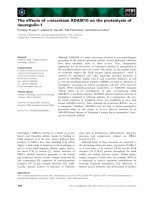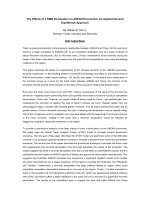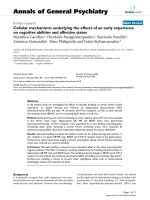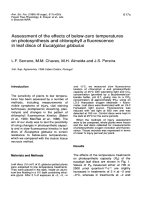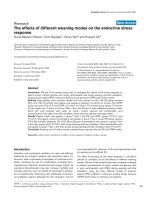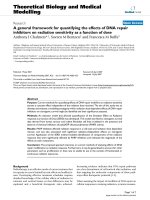The effects of online credible review on brand trust dimensions and willingness to buy: Evidence from Vietnam consumers / Trần Văn Đạt
Bạn đang xem bản rút gọn của tài liệu. Xem và tải ngay bản đầy đủ của tài liệu tại đây (2.12 MB, 15 trang )
<span class="text_page_counter">Trang 1</span><div class="page_container" data-page="1">
Full Terms & Conditions of access and use can be found at
<b>ISSN: (Print) (Online) Journal homepage: effects of online credible review on brand</b>
<b>trust dimensions and willingness to buy: Evidencefrom Vietnam consumers</b>
<b>Van Dat Tran, Minh Dung Nguyen & Lan Anh Lương</b>
<b>To cite this article: Van Dat Tran, Minh Dung Nguyen & Lan Anh Lương (2022) The</b>
effects of online credible review on brand trust dimensions and willingness to buy:Evidence from Vietnam consumers, Cogent Business & Management, 9:1, 2038840, DOI:10.1080/23311975.2022.2038840
<b>To link to this article: 2022 The Author(s). This open accessarticle is distributed under a CreativeCommons Attribution (CC-BY) 4.0 license.Published online: 21 Feb 2022.
Submit your article to this journal
Article views: 4449
View related articles
View Crossmark data
Citing articles: 4 View citing articles
</div><span class="text_page_counter">Trang 2</span><div class="page_container" data-page="2"><b>MARKETING | RESEARCH ARTICLE</b>
The effects of online credible review on brand trust dimensions and willingness to buy: Evidence from Vietnam consumers
Van Dat Tran<sup>1</sup>*, Minh Dung Nguyen<sup>2 </sup>and Lan Anh Lương<sup>3</sup>
<b>Abstract: This study investigated the relationship between source, receiver, review </b>
quality, review sidedness, review consistency, online credible review, reliability, intentionality, and willingness to buy the electric consumers in Vietnam. This study performed structural equation modeling (SEM). A total of 427 valid respondents were used in this research. The findings indicated that sources, receiver review, review quality, review sidedness, and review consistency have positive effects on online credible review. Moreover, it found that online credible reviews had
a significantly positive influence on the intentionality and reliability of brand trust. This research also illustrated that intentionality and reliability have a significant impact on willingness to buy. From academic contributions in this research, it has a variety of important indicators of online review credibility. Therefore, marketers should be mindful of the leading position played by periphery signals and focus on taking advantage of the latter to keep improving the credibility of the assessment process.
<b>Subjects: Marketing; Services Marketing; Brand Management; Consumer Behaviour Keywords: source; receiver; message; online credible review; brand trust; willingness to buy</b>
<b>JEL Classifications: M30; M31; M37</b>
Van Dat Tran
ABOUT THE AUTHORS
Van Dat Tran is a lecturer in marketing and rently heads the Department of Marketing, Faculty of Business Administration, Banking University of Hochiminh City, Vietnam. Presently, he teaches subjects such as consumer behaviors, consumer psychology, brand management, mar-keting management, and digital marketing. Minh Dung Nguyen is currently a PhD scholar at College of Management, National Kaohsiung University of Science and Technology, Taiwan Lan Anh Lương is currently a Master student in Business Administration, Banking University, Ho Chi Minh city, Vietnam
cur-PUBLIC INTEREST STATEMENT
Online product reviews are useful in providing information for customer decision-making. Besides, consumers are influenced by different online reviews of products on virtual platforms that make their mark on the minds of them. Organizations need to be knowledgeable about the value that online reviews deliver that helps organizations make more informed decisions. On the other hand, the relationships between trust and other e-service factors, especially the beha-vioral intention in the online environment, have yet to be deeply discussed. This study, therefore, provided a persistent finding, implying that receiver, review quality, sidedness, and consis-tency are all directly correlated to both the reliability and intentionality of online reviews. It also considers a new relationship between the credibility of online reviews and the intention among willingness to buy from customer’s side.<small>Received: 05 February 2021 </small>
<small>Accepted: 02 February 2022*Corresponding author: Van Dat Tran, Head of Marketing Department, Banking University, Ho Chi Minh City, Vietnam </small>
<small>E-mail: </small>
<small>Reviewing editor: </small>
<small>Teresa Villace, Business. Marketing Area, Universidad Rey Juan Carlos, Spain </small>
<small>Additional information is available at the end of the article</small>
<small>© 2022 The Author(s). This open access article is distributed under a Creative Commons </small>
</div><span class="text_page_counter">Trang 3</span><div class="page_container" data-page="3"><b>1. Introduction</b>
The world has many changes rapidly, which exists many new elements affecting consumer behavior in making purchasing decisions. In these elements, WOM (word of mouth) is mentioned, which has increased dramatically through the global and pervasive usage of the internet. It is also one of the most successful factors contributing to the definition of electronic WOM (eWOM). As what we know, it is possible to classify word of mouth (WOM) as informal contact between two or more individuals. In the context of globalization, online customer reviews seem to be the most popular type of eWOM and it has been shown that these online reviews have a major effect on the purchasing decision making of customers (Chen & Xie, 2008; Nguyen et al., 2020; Tran & Vu, 2019). Customers are likely to use WOM via the online mode known as electronic word of mouth (EWOM) in the new digital age. According to Prendergast et al. (2010), individuals also search for authentic sources with technical experience when choosing products, called word of mouth (WOM) or virtual word-of-mouth (eWOM) while online. Chang et al. (2013) pointed out that female target groups are attracted to the activities of e-WOM. In addition, online reviews not only exist in the specific field but they also appears very widely. Previous studies indicated that consumer reviews seem to be very important for consumer purchasing behavior and selling products (Chen & Xie, 2008). For example, in the hospitality field, online reviews seem to be a significant source of data influencing the decision-making of hospitality purchases by customers (Sparks et al., 2013). In addition, Cheng et al. (2013) also note that some previous studies on online evaluation (OR) only focused on short-term results such as purchase intent or willingness to purchase and “brand trust” (Schlosser et al., 2006) which essentially mediates the online assessments and short- term indicators (Chaudhuri & Holbrook, 2001). According to Xun (2014), consumers are influenced by different online reviews of products on virtual platforms that make their mark on their minds. Organizations need to be knowledgeable about the value that online reviews deliver that helps organi-zations make more informed decisions.
Many previous studies have found factors that influence the reliability of online reviews. However, very little research has explored the impact of online reviews on brands and consumer buying behavior. Therefore, in this study, not only that credible online reviews affect intention to buy, but it uses a multi-level model in which variables such as source (SO), receiver (RE), review quality (RQ), review sidedness (RS), and review consistency (RC) affect credibility of online reviews. In addition, it will identify how the variables online credibility reviews (OCRs) affect reliability (BTR) and intentionality (BTI). From those primary influences whether it will affect the higher ranking of the consumer purchase decision or not.
<b>2. Literature review and hypothesis</b>
Organizational branding initiatives are centered on the goal of ensuring that brands have a strong influence on potential buyers (Ahmad & Guzmán, 2020). It is common knowledge that brands with more brand equity enjoy greater customer loyalty (Pappu & Quester, 2016). The research of Farzin and Fattahi (2018) illustrated that consumer trust, informational influence, feeling of belonging, empathy, moral imperative, and knowledge self-efficacy were all found to be important for customer participa-tion in eWOM. It went on to say that eWOM, which played a big part in moulding customers’ perceptions of brands and their willingness to buy. As a result, consumer eWOM behavior, in turn, had a positive and significant impact on brand image and consumer purchase intention. Meanwhile, customer purchase intent was positively influenced by brand image. While Chakraborty and Bhat (2018b) argued that the impact of source and review quality on credibility judgment of online reviews is more important than the impact of review consistency and receiver. It was also discovered that the respondents viewed the reviews as a whole. As a result, we can deduce that buyers do not evaluate the sidedness of a particular review, but rather the aggregate of reviews (Baker et al., 2016). Moreover, Abedi et al. (2020) indicated that the quality and reliability of eWOM information has a favorable direct effect on perceived information usefulness. Shoppers found feedback from customers posted by their friends on social media to be reliable and valuable. People in mobile social networks rely on informa-tion provided by people they trust since they are familiarized with who generated WOM information
</div><span class="text_page_counter">Trang 4</span><div class="page_container" data-page="4">(Erkan & Evans, 2016). The effect of perceived information usefulness on information adoption is mediated by attitude toward eWOM information.
<i><b>2.1. Source</b></i>
In the research of Li et al. (2013), they found that source credibility was related to the perceived helpfulness of online shopping and relational partners (Cline, 1999). Wathen and Burkell (2002) found that source credibility is positively related to information credibility evaluation and related to information credibility (Luo et al., 2013). Chakraborty and Bhat (2018a) found that the source has statistically significant positive effects on online reviews’ credibility. Cheung and Thadani (2012) showed that there were two dimensions of source credibility including expertise and trustworthi-ness. Prior research studies on perceived homophily (Wright 2000) indicated that the relationship between opinion providers and recipients is very important. In addition, the component of homo-phily including perception-based similarity and demography similarity was developed by De Bruyn and Lilien (2008). Thus, the hypothesis is formulated as:
H1: Source is positively related to online credible review
<i><b>2.2. Receiver</b></i>
Li (2015) indicated that information quality was evaluated on the content, timeliness, and format. Ma and Agarwal (2007) indicated that the source identity of local communities determined their satisfaction. In addition, Tran and Can (2020) investigated that review consistency is related to review credibility. Uribe et al. (2016) found that credibility has affected behavior intentions. In addition, Hsu and Liao (2014) showed that customer received information two-sided recommen-dations are better than one-sided information. Similarly, Winter et al. (2015) indicated that receivers perceived two-sided information as more credible than one-sided information recom-mendations. Thus, the next hypothesis is formulated as:
H2: Receiver is positively related to online credible review
<i><b>2.3. Message</b></i>
Buyers generally seek the reliability of online reviews before they consider reviews (Shan, 2016). Besides, the review quality impacted on the online credibility reviews, which is in line with the research’s finding of Chakraborty and Bhat (2018a). In the research of Shankar et al. (2011), they found that online reviews with a clear source are considered to be more reliable than reviews without high-quality sources. Fan et al. (2013) showed that review quality is positively related to online credible reviews. Thus, the next hypothesis is formulated as:
H3: Review quality is positively related to online credible review
Forman et al. (2008) claimed that one-sided reviews were observed to be much more beneficial than two-sided reviews. However, Chakraborty (2019) does not support the theory that review sidedness clearly affects the reliability of online reviews. Moreover, Uribe et al. (2016) indicated that two-sided reviews improve credible information. Besides, they found that two- sided reviews affected behavioral intentions. Winter et al. (2015) believed that good-sided reviews could have more effects on the success of online reviews than one-sided reviews. Sidedness of the review as a seldom-used aspect of the quality of the knowledge was also considered to have a strong influence on the perceptions (Garg & Pandey, 2020). Finally, Baker et al. (2016) indicated that consumers did not consider the sidedness of a given review, but they consider reviews as an aggregate. Thus, the next hypothesis is formulated as:
</div><span class="text_page_counter">Trang 5</span><div class="page_container" data-page="5">H4: Review sidedness is positively related to online credible review
According to Chang et al. (2013), online customer reviews showed the establishment of a specific brand trust for all prospective customers via the idiotic comments of former customers. Based on the aforementioned outcomes of this report, there are many consequences for market-ing strategies in the context of e-commerce and social networking sites. By the various online reviews about products on the virtual world help to leave a deep impression on the customer’s mind (Xun, 2014). Luo et al. (2015) indicated that review consistency positively affected review credibility. On the flipside, if the particular comment is inconsistent with the other comments, then the receiverfeels confused and may not consider that particular comment as credible (Zhao el,
2017) . Thus, the next hypothesis is formulated as:
H5: Review consistency is positively related to online credible review.
<i><b>2.4. Brand trust</b></i>
The relationships between trust and other e-service factors, especially the behavioral intention in the online environment, have yet to be deeply discussed. This study follows the understanding of the effects of online reviews on brand trust. Trust is so important for making the relationship between brand and customer. Morgan and Hunt (1994) developed a brand trust scale with reliability and integrity dimensions, reliability, and intentionality (Delgado-Ballester, 2004). Moreover, Mayer et al. (1995) showed that trust affected risk-taking in a moderated by perceived risk. In addition, Deighton (1992) found that reliability dimension of brand trust affected customer and satisfaction (Kau & Loh, 2006). Meanwhile, another research from Chakraborty and Bhat (2018a) suggested that online credible review affected the hedonic brand image. Cheng et al. (2013) also noted that several previous online review studies (ORs) have only concentrated on short-term assessments and results such as purchasing intent or willingness to purchase and “brand confidence” (Schlosser et al., 2006) frequently serve as a mediator between online reviews. This leads to the following hypotheses:
H6a: Online credible review is positively related to reliabilityH6b: Online credible review is positively related to intentionality
<i><b>2.5. Willing to buy</b></i>
According to Chakraborty (2019), he pointed out the existence of online reviews on social media that significantly impacts brand trust and intentionality leading to the influence on willingness to buy. In addition, Grewal et al. (1994) showed that perceived risk was a critical determinant of consumer’s willingness to buy a product. Teo and Yeong (2003) found that perceived risk negatively affected customer purchases and had a positive effect on willingness to buy online. Moreover, Tran and Can (2020) examined that perceived risk affects online shopping behaviors and prevents perceived risk from increasing. Besides, Gambetta (1988) supposed that the relationship between the trustor’s beliefs about the trustee’s capabilities and about the context in which the relation occurs. It was revealed in Verhagen et al. (2006) study that e-trust has a positive effect on customer’s online shopping intentions. Another research from Chang et al. (2013) suggested that users focus on trust when they buy a product for the first time. They believe that intentionality is beyond the user’s control and that it is not critical when deciding to purchase. Finally, Gefen (2002) found that online customer trust positively related to shopping intentions. This leads to the following hypotheses:
H7a: Reliability is positively related to willingness to buy
</div><span class="text_page_counter">Trang 6</span><div class="page_container" data-page="6">H7b: Intentionality is positively related to willingness to buy
<b>3. Methodology</b>
<i><b>3.1. Research framework</b></i>
The purpose of this study is to access the relationship between the source, receiver, message, online credible review, brand trust, and willingness to buy. Thus, based on the literature review and hypothesis formulation. The following is the research framework (Figure Figure 1):
<i><b>3.2. Questionnaire design</b></i>
Questionnaires were used in this study. Credible online reviews and sources were measured with items based on Cheung et al. (2008). In order to measure message and receiver, modified items of scale were developed by Cheung et al. (2009). The study by Delgado-Ballester (2004) was followed to confirm the items to measure reliability and intentionality. Finally, to measure willingness to buy, we adopt items from Grewal et al. (1998). All the items were measured through a five-point Likert scale, where 1 = strongly disagree and 5 = strongly agree (Table 1)
<i><b>3.3. Demographic statistics</b></i>
The questionnaires were distributed to 450 respondents on a Google form. Of which, there have been 427 responses that are valid. There have been 23 invalid responses because the respondents have not answered correctly the reversed scale questions.
<i><b>3.4. Confirmatory factor analysis (CFA)</b></i>
According to Bagozzi and Foxall (1996), confirmatory factor analysis (CFA) is a method to assess reliability and validity. CFA was applied with the following indexes: Chi-square/df (cmin/df) = 1.224, Goodness-of-fit index (GFI) = 0.929, adjusted goodness-of-fit index (AGFI) = 0.912, comparative fit index (CFI) = 0.992, root mean squared error of approximation (RMSEM) = 0.0224, and Tucker Lewis Index (TLI) = 0.990. Therefore, all the factors in this research were within the accepted level (Table 2)
Construct Validity: The reliability of all the variables including source, message, receiver, review quality, review sidedness, review consistency, online credible review, reliability, intentionality, and willingness to buy were in the range of 0.885–0.941 (Table 3). Reliability results were acceptable.
<b>Figure 1. Research framework.</b>
</div><span class="text_page_counter">Trang 7</span><div class="page_container" data-page="7">According to Hair et al. (2009), the factor loading of all items was more than 0.5. In addition, the average variance extracted (AVE) for each construct is greater than 0.5 and the construct reliability (CR) of all the latent variables was more than 0.7. All the indicators had significant loading into the respective latent constructs with values between 0.719 and 0.774. Therefore, results were acceptable (Table 3)
Discriminant validity was tested by comparing the square root of AVE of a latent construct is higher than all the constructed correlations. The results showed that square of AVE values of all the variables, source, message, receiver, review quality, review sidedness, review con-sistency, online credible review, reliability, intentionality, and willingness to buy are higher than the inter-construct correlations (Table 4). Therefore, the results were acceptable (Hair et al., 2009)
<i><b>3.5. Hypothesis testing</b></i>
After acceptable reliability and validity results (Figure 2), we formulated a structural equation model to examine the hypothesis. Various indices of the structural model normed, chi-square /df (cmin/df) = 1.233, goodness-of-fit index (GFI) = 0.926, adjusted goodness-of-fit index (AGFI) = 0.912, comparative fit index (CFI) = 0.991, root mean squared error of approximation (RMSEM) = 0.023, and Tucker Lewis Index (TLI) = 0.990. All the results were accepted (Hair et al., 2009).
Data analysis indicated that the source has significant effects to online credible review
<i>(β = 0.168 and p < 0.001). Thus, H1 is supported. Besides, the receiver has significant positive effects on online credible review (β = 0.195 and p < 0.001). In addition, the review quality (β = 0.216 and p < 0.001, review sidedness (β = 0.299 and p < 0.001), and the review consistency (β = 0.225 and p < 0.001) have a significantly positive impact on online credible </i>
<b>Figure 2. Model tests.</b>
</div><span class="text_page_counter">Trang 8</span><div class="page_container" data-page="8">review. Thus, H3, H4, and H5 are supported. Moreover, online credibility review is significantly
<i>positive relating to reliability (β = 0.665 and p < 0.001) and intentionality (β = 0.583 and </i>
<i>p < 0.001). Thus, H6a and H6b are supported. Finally, reliability (β = 0.357and p < 0.001) and </i>
<b>Table 1. Response rate of groups</b>
<b>Table 2. Confirmatory factor analysis</b>
Chi-square/df (cmin/df) ≤2 good; ≤sometimes permissible
1.224 Hair et al. (2009)Goodness-of-fit index
≥0.9: acceptable; ≥0.8: marginal
0.929 Hair et al. (2009)Adjusted goodness-of-fit
index (AGFI)
≥0.8 0.912 Hair et al. (2009)Comparative fit index
≥0.95 great; ≥0.90 traditional; ≥0.80 sometimes
0.992 Hair et al. (2009)
Root mean squared error of approximation (RMSEM)
≤0.05 good; ≤0.08 moderate
0.0224 Hair et al. (2009)
Tucker Lewis Index (TLI) ≥0.90 0.990 Hair et al. (2009)
</div><span class="text_page_counter">Trang 9</span><div class="page_container" data-page="9"><i>intentionality (β = 0.465 and p < 0.001) have a significant positive effect on the willingness to </i>
buy (Table 5).
<b>4. Discussion</b>
Despite the substantial consumer doubts about the credibility of online reviews and the little scientific information about what influences the associated perception of consumers. The objec-tives of this paper would have been to evaluate and understand the determinants of the credibility of online reviews as well as their impact also on the buying intentions of consumers. The critical outcome of this research is the empirical affirmation of coexistence and the separate but inter-related impacts of these features. Based on previous research findings such as Djafarova and Rushworth (2017), this research also found that the source has statistically significant positive effects on online reviews’ credibility assessment through accepting the H1. To prove this
<b>Table 3. Confirmatory factor analysis (CFA) fitting indices</b>
</div><span class="text_page_counter">Trang 10</span><div class="page_container" data-page="10">hypothesis strongly, Ma and Agarwal (2007) also said that the source identity of local communities determined their satisfaction. Xie et al. (2011) also evaluated the effect of the online reviewer’s source identification on the legitimacy of evaluation and purchase intention under periodically re- decisional structures. Shanka et al. (2011) also confirmed that an online review with an identified source was deemed more reliable and contributed to improved initial trust. If they regard the source of the reviews as reliable, customers are likely to trust the reviews. In addition, the hypothesis of the effect of the receiver on credible online review was supported by the author, which is in line with the research of Chakraborty (2019). He showed that if the receiver under-stands that the reviews contain compelling points, then the reviews would be followed. Since they want to believe the reviews that complement his/her preconceived evidence and experience, then individual tends to endorse and believe the reviews (Cheung et al., 2009). Upon the effect of other factors, the quality of reviews also becomes statistically meaningful, with beneficial outcomes on reliable online reviews. Therefore, this research supposed that the review quality impacted on the online credibility reviews, which is the same finding as the research of Chakraborty and Bhat
<b>Table 4. Discriminant validity and correlations among the constructs</b>
<b>Table 5. Results of significance test for paths of the model</b>
0.665*** SupportedH6b Online credible review ➔
0.583*** SupportedH7a Credibility ➔ Willingness
</div>
